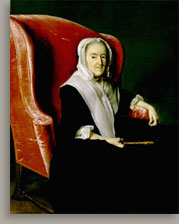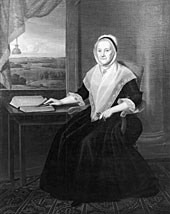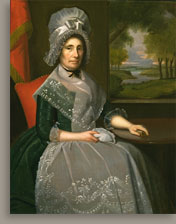 Christian Gullager Christian GullagerMartha Saunders Salisbury (Mrs. Nicholas Salisbury), 1789 Description Salisbury wears a plain dress made of silk or satin with three-quarter-length sleeves. Gullager painted the shimmer of the fabric with gradations of light and dark green and added final highlights of opaque white. The white ruffles of plain linen on the sleeves of her shift are made of a similar sheer material to that of her hood and scarf. Both garments are trimmed with white ribbons that the artist rendered with opaque white paint that has a slight impasto. Salisbury sits in an easy chair that is covered with rose-colored damask. To depict the floral pattern of the upholstery, Gullager worked simultaneously with light and dark pinks. However, the horizontal opaque pink highlights on the left wing of the chair were clearly added on top. Salisbury leans her proper right elbow on the arm of the chair. Between the thumb and index finger of her proper right hand, she holds a pair of steel-rimmed spectacles with silver-colored loops on the ends. A large Bible is open on the small wooden table in front of her to John 5:39, and a partially open green and silver snuff box is nearby. Salisbury's proper left arm rests on the open Bible and her fingers point to the first and only legible line of text, which reads, "Search the Scriptures." Strong light falls from the upper left to the lower right, casting shadows and creating highlights throughout the painting. Gullager included a grayish-brown wall in the background that is in dark shadow to the left of the chair. Biography In addition to raising her six surviving children, Martha continued her husband's business—importing tea, German steel, and wool cards—even after her sons were established in business.6 Martha's correspondence reveals her financial savvy and careful management of the business. On August 5, 1767, for instance, her London suppliers, Lane, Fraser & Son, replied to a letter in which she complained of the high price that she had been charged for wool cards.7 During the Revolution, Martha sought safety in the central Massachusetts town of Worcester, where her youngest son, Stephen (1746–1829), had moved in 1767. Martha was joined in Worcester by her son Samuel (1739–1818) and his family as well as her unmarried daughter Sarah (1745–1828).8 Stephen had ventured to Worcester as his brother Samuel's new business partner and established a branch of the family business there. At the end of the war, Samuel and Sarah returned to Boston, whereas Martha remained in Worcester with Stephen until her death on February 18, 1792.9 She was buried with her husband in King's Chapel Burial Ground in Boston.10 Analysis
Although the portraits of Elizabeth Sewall Salisbury and Elizabeth Salisbury Barrett were sent to their families, Stephen kept his own and his mother's likenesses. Whether Gullager intended it, the portraits of Martha and Stephen (fig. 1) formed a pair and probably hung together in Stephen's mansion. The two paintings are in the same kit-cat format and cost just over five pounds each, whereas Gullager's portraits of Elizabeth Salisbury and Elizabeth Barrett were bust size and cost about four pounds apiece.18 Both Martha and Stephen are seated in front of a neutral brown wall. Whereas the figures in paired portraits typically turn toward one another, Gullager sometimes painted them facing the same direction. That is the case in the portraits of Martha and Stephen Salisbury as well as those of Offin Boardman and Sarah Boardman. Companion portraits usually represent a husband and wife; however, Gullager's portraits of Stephen and Martha were emblematic of the mother-and-son Salisbury household in which they lived. Martha was not just a visitor in her son's home, she was a dominant presence. When she lived in Boston, her son Samuel complained to his brother:
Samuel found an even more satisfying solution by moving back to Boston at the close of the Revolution and leaving his mother behind in Worcester. Stephen Salisbury remained a bachelor until after his mother's death. The eighty-five-year-old Martha Salisbury was Gullager's oldest sitter. Rather than portray the aged Martha as feeble, he represented her as the shrewd woman to whom her sons referred in correspondence as their "honoured mother." Martha is not overpowered by the large easy chair, as is the elderly sitter in John Singleton Copley's portrait Anna Dummer Powell (Mrs. John Powell) (fig. 2). Salisbury fills the chair more completely than Powell, and Gullager brought his subject further forward than Copley did his. The relative impact is that Salisbury is a more commanding figure than Powell.
Snuff boxes, like the one in the foreground of Salisbury's portrait, are unusual features in women's portraits of the period. Snuff, a powdered tobacco that is inhaled through the nostrils, was used by both sexes. The British artist William Hogarth (1697–1764) shows a widow dressed in mourning taking a pinch of snuff from a gentleman in his Family Portrait (British Museum, London). Ralph Earl represented the fifty-two-year-old widow Mary Alsop (fig. 4) with her left hand resting on a snuff box and her right hand holding a handkerchief. A passage from Lucy Temple, a novel by the American writer Susanna Rowson (1762–1824), helps the modern viewer to understand the relationship between a snuff box and a handkerchief: "Mrs. Cavendish had taken a large pinch of snuff, and. . . wiped the poudre tabac from her upper lip with one of the finest coloured silk handkerchiefs."27 In the eighteenth century snuff had both advocates and critics, and in the nineteenth century was claimed to have medicinal value.28 An eighteenth-century magazine even published a poem dedicated to the snuff habit:
Martha is known to have used snuff and her sons sold it in their store.30 As with the chair and Bible, the snuff box appears to have been carefully chosen to personalize the portrait of Martha Salisbury. Notes 2. Salisbury 1885, I, 13–17, 36–37, 128; Nutt 1919, I, 221; and Hill 1890, II, 258. 3. Salisbury 1885, I, 20–21, 30, 32. 4. Suffolk County Deeds, Massachusetts Archives, 61:32, January 28, 1740, and 71:107, January 1, 1745. For Elbridge's will, see Salisbury 1885, I, 124–28. 5. The Boston Gazette or Weekly Journal, December 13, 1748 noted Lord's Day Morning died here Mr Nicholas Salisbury, Shopkeeper. 6. Martha Salisbury, Account Book, 1753–1773, Salisbury Family Papers, American Antiquarian Society, Worcester, hereafter cited as SFP, AAS, octavo vol. 4. 7. Lane, Fraser & Son, London, to Martha Salisbury, Boston, August 5, 1767, SFP, AAS, box 1, folder 2. 8. Samuel Barrett, Boston, to Stephen Salisbury I, Worcester, May 3, 1775, SFP, AAS, box 3, folder 3. 9. The Columbian Centinel, Boston, February 22, 1792, recorded her death: "In Worcester, Mrs. MARTHA SALISBURY, AEt. 88. A Lady, who, through life, exhibited an amiable and uniform example of truly christian piety, purity, and charity." 10. Bridgman 1853, 150. 11. Stephen Salisbury I, Account Book, 1783–1810, SFP, AAS, oversize vol. 1, 286. 12. Samuel Barrett, Boston, to Stephen Salisbury I, Worcester, March 25, 1789, SFP, AAS, box 5, folder 6. 13. Samuel Salisbury, Boston, to Stephen Salisbury, Worcester, April 29, 1789, SFP, AAS, box 5, folder 6. 14. Samuel Salisbury, Boston, to Stephen Salisbury I, Worcester, May 28, 1789, SFP, AAS, box 5, folder 6. 15. Samuel Salisbury, Boston, to Stephen Salisbury I, Worcester, May 31, 1789, SFP, AAS, box 5, folder 6. 16. Samuel Salisbury, Boston, to Stephen Salisbury I, Worcester, May 31, 1789 and June 16, 1789, SFP, AAS, both box 5, folder 6; and Stephen Salisbury II, Memoranda of Portraits, SFP, AAS, octavo vol. 62, 37. 17. Samuel Salisbury, Boston, to Stephen Salisbury I, Worcester, September 6, 1789, SFP, AAS, box 5, folder 6. 18. Stephen Salisbury II, "Memoranda of Portraits," SFP, AAS, octavo vol. 62, 37 and 49. 19. Samuel Salisbury, Boston, to Stephen Salisbury I, July 12, 1769, SFP, AAS, box 2, folder 1. 20. For the iconography of book and the venerable sitter, see Docherty 1998, 338. 21. For steel spectacles, see Rosenthal 1996, 100. A similar pair of spectacles (1907.390) to the ones worn by Martha Salisbury in her portrait were given to the museum by Stephen Salisbury III. 22. "Inventory of the personal estate of Mrs. Martha Salisbury, decd.," filed December 13, 1792, Worcester County Register of Probate, Worcester, Mass. 23. Bushman 1993, 271–72. 24. Cooper 1980a, 66. 25. Daniel Waldo, Providence, to Stephen Salisbury I and Samuel Salisbury, Worcester, December 5, 1775, SFP, AAS, box 3, folder 3. 26. Martha Salisbury estate inventory. 27. Rowson 1991, 210. 28. Stanhope 1788; E[ ]. 1787; Benvolio 1787; Whitwell 1813; and The Massachusetts Spy and Worcester County Advertiser, August 5, 1829. For snuff boxes, see Jestin 1990 and Le Corbeiller 1966. 29. "The Virtues of the Book-Snuffbox," New Hampshire Magazine 1: 4 (September 1793): 253. 30. Advertisement for Samuel and Stephen Salisbury, Worcester store, Thomas's Worcester Spy or American Oracle of Liberty, November 26, 1778. For Martha's snuff purchases, see Samuel and Stephen Salisbury, Account Book of General Merchandise, 1783–1810, SFP, AAS, oversize vol. 1, 121, 255. |



